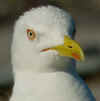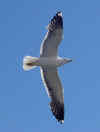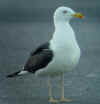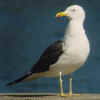updated: 11-11-2003
Images presented in this section were taken in Stockholm during a short stay on August 03 & 04 2002 and on the Tampere landfill during the 6th International Gull Conference.
Primary moult
The moult sequence in nominate Lesser
Black-backed Gull Larus fuscus fuscus was already described by
Stresemann & Stresemann in 1966 in Journal für Ornithologie. They
described a periodische Staffelmauser, a step-wise moult. Normally,
large white-headed gulls in Europe start replacement of the remiges during
the breeding season and finish this moult in autumn, prior to their
migration. Compared to fuscus, this is a relative short distance
migration.
Stresemann & Stresemann describe fuscus as an exception as it
doesn't start the remiges moult before arriving at the wintering grounds
in Africa and the Mediterranean. For a long-distance migrant like fuscus,
this seems to be a suitable strategy. This pattern can also be found in
long-distance migrants like Terns (Sternidae).
Stresemann & Stresemann examined skin collections and failed to find
any adult L. f. fuscus originating from the breeding or autumn
migratory range that was in active primary moult. Therefore they presumed
the entire moult stage takes place on the wintering grounds. Adult birds
on migration had been collected (Rossitten Bird Observatory, Russia) and
these birds confirmed the theses: they must have suspended moult, as
Heinroth (1928, Die Vögel Mitteleuropas) concluded: adult fuscus
doesn't show active primary moult on migration. They either suspend moult
or do not commence moult before arrival on the wintering grounds.
However, there are a few museum skins that do show adult fuscus in
primary moult: the Zoological Museum of Helsinki (not visited by the
Stresemanns in 1966) has 21 skins of summer / early autumn birds: 8 are
showing moult in the primaries. The museums of Copenhagen and Tring have
10 skins in collecting from the same period: one is showing active primary
moult.
The last decades, the general idea about the renewal of the primaries in adult fuscus has been changed slightly. Field research showed that a small majority (up to 60% in southern Sweden) of the adult fuscus have started to replace the inner one or two primaries on the breeding ground by late August. This primary moult is suspended until arrival at the tropical wintering grounds. Fuscus complete their primary moult in February and March, just before leaving again to the breeding grounds in Scandinavia and northern Russia. By March, the inner primaries may in some birds included in the primary moult, in a second wave. This seems to be a common feature in sub-adults.
Hario and primary moult in fuscus
An interesting article
about primary moult in Finland has been published by Ornis Fennica
(61/1984): Onset and pattern of primary moult in the Lesser Black-backed
Gull Larus f. fuscus - a comparison with the Herring Gull, written
by Martti Hario. Hario, working for the Game & Fishery Institute in
Helsinki, did a four year investigation (breeding seasons of 1980-83) in
the outer archipelago of the Gulf of Finland, 25 km SE of Helsinki
(60.07N-25.25E). This archipelago hosts a small mixed colony of fuscus
and argentatus, with about 25 pairs of both species, but steadily
declining numbers of fuscus. Systematically, shed feathers of both fuscus
and argentatus were collected from the time eggs were laid up to
September. During the visits, the number of birds were noted and the
breeding success was studied in detail. By collecting the shed primaries
systematically, Hario was sure about the feathers being shed very recently
(he worked on a daily basis for most of the period). To draw his main
conclusion, Hario plotted the length of the newly shed primaries against
time (n = 337 for argentatus, n = 137 for fuscus) to get a linear
regression analysis.
From early May argentatus shed primaries, starting with the
innermost primaries, P1, P2, etc. until P10 is dropped. This is clearly
demonstrated by the length of the shed primaries Hario collected; getting
longer as time progresses. The first collected primaries in May are about
180 mm in length, the last shed primaries, collected in early August are
about 280 mm and clearly apply to the longer outer primaries. From early
August onwards, adult argentatus normally abandon the colony and
may still have the old outermost primaries present.
The figure for fuscus is completely different with the length of
the shed primaries staying more or less the same over a period of three
months (regression coefficient only 0.05, with coefficient for argentatus
0.89). Thus, fuscus only moults the short inner primaries in the
study area in southern Finland, probably primaries P1, P2 and occasionally
(?) P3. Moult is then interrupted or continued outside the study
area.
Argentatus left the colony in the study area as the young
fledglings were leaving the area. Fuscus on the contrary remained
in the area, despite the poor breeding results and stayed up to the end of
August; last birds were seen mid-September.
| Table 1 from M. Hario (1984): Numbers of shed primaries collected in the study area and sizes of breeding gull populations (ind.) in different years. | ||||
| . | L. f. fuscus | L. argentatus | ||
| . | primaries | breeding birds | primaries | breeding birds |
| 1980 | 38 | 62 | 52 | 50 |
| 1981 | 11 | 64 | 108 | 50 |
| 1982 | 46 | 44 | 114 | 52 |
| 1983 | 42 | 30 | 63 | 42 |
Hario found no statistical difference in feathers from left or right wing. Hence, birds moulting P1 or P2 (and occasionally P3), the average number of birds shedding primaries would be 17 or 9 (or 6) respectively. From table 1, one may conclude this represents 34% or 18% (or 12%) of the fuscus population in 1980-1983. This is a minority, but substantial number of adult fuscus.
Hario didn't only check the timing of moult, he also noted the patterns of primary moult. He collected newly shed primaries of fuscus and argentatus and as expected, the primaries of argentatus were pretty worn, being almost a year old. Remarkably, this wasn't always the case in fuscus. Some shed inner primaries were very fresh, with the clear white tip still visible. This is so remarkable, considering the much longer migration route for fuscus and the exposure to desert sun in the equatorial summer. The difference in wear suggest a difference in age of the feathers. Hario found only small numbers of intermediates. Exactly in line with the findings of Stresemann & Stresemann's 'periodische Staffelmauser'. Hario estimates the fresh primaries to be only 1-2 months of age, which is the time interval between arrival at the breeding grounds and completion of the second moult wave in the inner primaries. Thus the fresh primaries belong to birds having moulted stepwise, and the worn ones to those having moulted 'normally'.
| Table 2 from M. Hario (1984): Proportions of fresh and worn primaries of L. f. fuscus and those of intermediate type collected in the study area. | |||||||
| . | fresh | worn | intermediate | total | |||
| . | n | % | n | % | n | % | . |
| 1980 | 6 | 16 | 27 | 71 | 5 | 12 | 38 |
| 1981 | 5 | 45 | 6 | 55 | 0 | - | 11 |
| 1982 | 3 | 7 | 42 | 91 | 1 | 2 | 46 |
| 1983 | 7 | 17 | 31 | 74 | 4 | 9 | 42 |
| average | . | 21 | . | 73 | . | 6 | . |
The proportion of birds moulting stepwise average 20% of the moulting adults. As demonstrated earlier, about 18-34% (lower limit may be 12%) of adult fuscus shed primaries by late summer - early autumn but the proportion of stepwise moulting birds in the total population can be estimated as the moult strategy in non-moulting birds is unknown.
In discussing the primary moult of adult fuscus on the breeding grounds, Hario questions whether fuscus may start moulting earlier because of the great loss of chicks and the poor breeding success. About 90% of the fuscus chicks had died before the start of the primary moult in adults. Nevertheless, the commencement of the primary moult takes place with a one-month time gap and there are no indications adults start moulting earlier and stays the same as in the 1960's. Barth, who based his findings on samples from 1962-1970 draws the same conclusion: primary moult starts at earliest from mid-July and commonly on August 10. But there is a slight change that, given the 'surplus' time between failed breeding and migration, fuscus may start the primary moult earlier in the next generations. For a summary of Barth's article, click here.
The
survey on primary moult in adult fuscus was repeated by Lars
Jonsson on Gotland. In his article "Baltic Lesser Black-backed Gull Larus
fuscus fuscus - moult ageing and identification" in Birding World
11-8 1998 he mentions this research op page 303.
"I have systematically checked fuscus resting at the southern
top of Gotland for primary moult from July through to mid September and
have found that 60% of the fully adult-looking birds have started the
renewal of their innermost one or two primaries by the end of
August".
He doesn't enlarge upon these figures and there is no table included
showing total numbers included in this survey, but the '60%' is
substantial larger than the '25%' estimation of Hario. A few factors may
have influenced this estimation:
- Jonsson's research extended much longer, into September, and may have
included birds commencing primary moult in a later stage.
- Jonsson included all adult-looking birds, and he may have included
near-adults as well. Near-adults may still start the renewal earlier than
true adults. Hario, checking breeding adults in the colony, had probably
lower numbers of 4cy and 5cy birds.
- Jonsson's research was done in the mid and late 90's, and, given the
poorer and poorer breeding successes for fuscus in the last
decades, there may be a minor shift in moult strategy due to 'surplus
energy and surplus time', as was questioned by Hario in the early 80's.
 Larus
fuscus fuscus adult, August 03 2002, Stockholm, Sweden. The
head feathers on crown and nape are heavily worn by August.
Larus
fuscus fuscus adult, August 03 2002, Stockholm, Sweden. The
head feathers on crown and nape are heavily worn by August. Larus
fuscus fuscus adult, August 04 2002, Stockholm, Sweden. The
centre of Stockholm with fuscus Lesser Black-backed Gulls. The
quays of the "old town" are the best bet.
Larus
fuscus fuscus adult, August 04 2002, Stockholm, Sweden. The
centre of Stockholm with fuscus Lesser Black-backed Gulls. The
quays of the "old town" are the best bet. Larus
fuscus fuscus adult, August 03 2002, Stockholm, Sweden. Two
adult fuscus with a 3cy argentatus and a juvenile fuscus.
Most adults don't start moult by early August, but there are exceptions,
like this individual, which started the wing-covert moult.
Larus
fuscus fuscus adult, August 03 2002, Stockholm, Sweden. Two
adult fuscus with a 3cy argentatus and a juvenile fuscus.
Most adults don't start moult by early August, but there are exceptions,
like this individual, which started the wing-covert moult. Larus
fuscus fuscus adult, August 03 2002, Stockholm, Sweden. The
majority of adults still have all primaries present in the first week of
August. This individual has the tail-feathers in remarkable good
condition.
Larus
fuscus fuscus adult, August 03 2002, Stockholm, Sweden. The
majority of adults still have all primaries present in the first week of
August. This individual has the tail-feathers in remarkable good
condition. Larus
fuscus fuscus adult, August 03 2002, Stockholm, Sweden. A
minority started primary moult by early August, with this individual
missing p1. As seen in many birds, only p10 has a mirror.
Larus
fuscus fuscus adult, August 03 2002, Stockholm, Sweden. A
minority started primary moult by early August, with this individual
missing p1. As seen in many birds, only p10 has a mirror. Larus
fuscus fuscus adult, August 03 2002, Stockholm, Sweden.
Probably the most advanced primary moult in adult fuscus. In the
left wing p1-3 are missing and it's just the moment that p3 will be
dropped in the the right.
Larus
fuscus fuscus adult, August 03 2002, Stockholm, Sweden.
Probably the most advanced primary moult in adult fuscus. In the
left wing p1-3 are missing and it's just the moment that p3 will be
dropped in the the right. Larus
fuscus fuscus adult, August 03 2002, Stockholm, Sweden. In
this bird the scapular coverts have worn away largely, almost to the base
of the feathers, creating a more than average tertial-step.
Larus
fuscus fuscus adult, August 03 2002, Stockholm, Sweden. In
this bird the scapular coverts have worn away largely, almost to the base
of the feathers, creating a more than average tertial-step. Larus
fuscus fuscus adult, August 03 2002, Stockholm, Sweden.
Note the large mirror on p10 and the strong brown hue on the old and worn
wing-coverts and scapulars.
Larus
fuscus fuscus adult, August 03 2002, Stockholm, Sweden.
Note the large mirror on p10 and the strong brown hue on the old and worn
wing-coverts and scapulars. Larus
fuscus fuscus adult, August 03 2002, Stockholm, Sweden. A
pitch-black adult with a brown hue on the edges of the greater coverts and
on the lowest lower scapulars. The carpal edge lacks the brown hue.
Larus
fuscus fuscus adult, August 03 2002, Stockholm, Sweden. A
pitch-black adult with a brown hue on the edges of the greater coverts and
on the lowest lower scapulars. The carpal edge lacks the brown hue. Larus
fuscus fuscus adult, August 03 2002, Stockholm, Sweden.
Another pitch-black adult lacking the brown hue on the edges of the wing-
coverts. This is probably the darkest fuscus present. The dark
upper-parts, the slender bill, elongated wings and small size make it an
attractive gull.
Larus
fuscus fuscus adult, August 03 2002, Stockholm, Sweden.
Another pitch-black adult lacking the brown hue on the edges of the wing-
coverts. This is probably the darkest fuscus present. The dark
upper-parts, the slender bill, elongated wings and small size make it an
attractive gull. Larus
fuscus fuscus, August 03 & 04 2002, Stockholm, Sweden.
An individual which is not easily aged as there is still some black on the
bill and some of the wing-coverts are very pale brown. P10 and p9 show a
mirror.
Larus
fuscus fuscus, August 03 & 04 2002, Stockholm, Sweden.
An individual which is not easily aged as there is still some black on the
bill and some of the wing-coverts are very pale brown. P10 and p9 show a
mirror. Larus
fuscus fuscus adult, August 04 2002, Stockholm, Sweden.
An adult fuscus with tertial #5 showing a pronounced dark centre,
which may be an indication for immaturity.
Larus
fuscus fuscus adult, August 04 2002, Stockholm, Sweden.
An adult fuscus with tertial #5 showing a pronounced dark centre,
which may be an indication for immaturity. Larus
fuscus fuscus adult, August 04 2002, Stockholm, Sweden.
An adult fuscus showing red on the upper mandible.
Larus
fuscus fuscus adult, August 04 2002, Stockholm, Sweden.
An adult fuscus showing red on the upper mandible. Larus
fuscus fuscus adult, August 04 2002, Stockholm, Sweden.
An adult fuscus with a broken leg. The tail is completely white and
no tail-feathers have been shed. P1-10 are present.
Larus
fuscus fuscus adult, August 04 2002, Stockholm, Sweden.
An adult fuscus with a broken leg. The tail is completely white and
no tail-feathers have been shed. P1-10 are present. Larus
fuscus fuscus adult, August 04 2002, Stockholm, Sweden.
An adult fuscus which has started the moult of the wing-coverts.
Larus
fuscus fuscus adult, August 04 2002, Stockholm, Sweden.
An adult fuscus which has started the moult of the wing-coverts. Larus
fuscus fuscus adult, August 04 2002, Stockholm, Sweden. In the scapulars about 50% of
the feathers is pitch-black, while the other 50% has the same delicate
brown hue. Note the hint of black on the curve of the upper mandible.
Larus
fuscus fuscus adult, August 04 2002, Stockholm, Sweden. In the scapulars about 50% of
the feathers is pitch-black, while the other 50% has the same delicate
brown hue. Note the hint of black on the curve of the upper mandible. Larus
fuscus fuscus adult, August 04 2002, Stockholm, Sweden. Primaries p1-p7
appear fresher than the outer primaries p8-p10, which lack white tip. The
white tips on p6 and even p7 are very obvious and hardly worn.
Larus
fuscus fuscus adult, August 04 2002, Stockholm, Sweden. Primaries p1-p7
appear fresher than the outer primaries p8-p10, which lack white tip. The
white tips on p6 and even p7 are very obvious and hardly worn. Larus
fuscus fuscus adult, August 04 2002, Stockholm, Sweden. An
elongated, long-winged adult fuscus.
Larus
fuscus fuscus adult, August 04 2002, Stockholm, Sweden. An
elongated, long-winged adult fuscus. Larus
fuscus fuscus
CORA
3cy, August 08-09 2002, Tampere, Finland (61.33N 24.59E).
Click the thumbnail to go to several ringed
individuals from the Finnish ringing program.
Larus
fuscus fuscus
CORA
3cy, August 08-09 2002, Tampere, Finland (61.33N 24.59E).
Click the thumbnail to go to several ringed
individuals from the Finnish ringing program.
 Larus
fuscus intermedius / fuscus adult, August 04 2002, Stockholm, Sweden.
A slightly stronger built, larger and more powerful bird with a pronounced
angular bill and head.
Larus
fuscus intermedius / fuscus adult, August 04 2002, Stockholm, Sweden.
A slightly stronger built, larger and more powerful bird with a pronounced
angular bill and head.